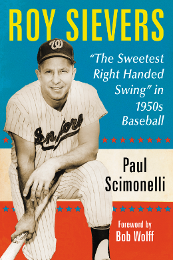November 11
Senator Managers
Bucky Harris, 1924-1928 (First stint)
Record as Senator Manager: 1,336-1,416, .485 Pct.
Teams managed:
1924: 92-62 .597 1st World Champions
1925: 96-55 .636 1st AL Pennant
1926: 81-69 .540 4th
1927: 85-69 .552 3rd
1928: 75-79 .487 4th*Note: Bucky Harris managed the Senators 3 separate times in his career. For the sake of continuity, each of his stints will be profiled separately into separate posts.*
Stanley “Bucky” Harris was on a Florida vacation in early 1924 when he received a letter from Clark Griffith. Harris believed the letter was a reprimand and a fine for his playing pro basketball during that off-season. But, to the shock of Harris, Griffith’s letter named him the new player/manager of the Senators. Despite being one of the youngest players on the team at 27, Griffith felt Harris had the right attributes to be a manager someday, so why not now? Harris was a leader and a scrapper, traits the “Old Fox” held in high esteem for his managers.
Harris would state years later that a good manager had to how to get along with the players. This formula worked to perfection in his first two seasons at the helm. During spring training and road trips, Harris rarely had bed checks and instituted an honor systems for his squad. His methods quickly gained him the respect of the veteran players on the Nats, such as Goose Goslin, Joe Judge, Walter Johnson and Roger Peckinpaugh. Despite a slow start out of the gate in 1924 that had sportswriters labeling Harris’ hiring as “Griffith’s Folly”, the Senators soon got hot and found themselves neck and neck with the Yankees for 1st place. Riding Walter Johnson, Washington clinched their first AL pennant at Boston on the final weekend of the season, earning them a date with the Giants in the 1924 World Series. The Senators won a thrilling, hard fought 7 game series from the Giants, making Johnson, Griffith and, especially Harris, the toast of D.C.
With offseason acquisition Stan Coveleski and Johnson winning 20 apiece, along with Dutch Ruether chipping in 18, the Senators of 1925 fought off an early challenge from the upstart A’s to win the AL going away. Goslin bashed in 113 RBI and Peckinpaugh took home MVP honors. Favorites to win the World Series against Pittsburgh, Washington took a seemingly insurmountable 3 games to 1 lead. However, Peckinpaugh’s 8 errors and Harris’ questionable use of the pitching staff cost Washington, enabling Pittsburgh to win the Series in 7 games.
In 1926, the Nats never seriously contended and would need a win on the last day of the season to finish in 4th place. Johnson and Coveleski seemed to slow down at the same time and the offseason trade for “Bullet” Joe Bush was a dud. Goslin hit .354 with 108 RBI, but he was suspended by Harris in August for “indifferent” play. With Peckinpaugh losing a step, Harris inserted Buddy Myer. The 22 year old Myer was more than adequate, batting .304 with 62 RBI, as Peckinpaugh’s replacement..
Looking to make one last run at another title in 1927, Griffith signed future Hall of Famer Tris Speaker. Harris planned on pitching the 39 year old Johnson in spots to hopefully maximize his production. Harris’ plan was foiled when Johnson went down with a broken leg in spring training. When Johnson returned 6 weeks later, he was a shell of his former self, finishing at 3-6 in his last season. To make matters worse, Speaker convinced Griffith and Harris to part with Myer for Boston SS Topper Rigney in May. Rigney would be released after 45 unproductive games. While the Nats finished at 85-69, good enough for 3rd place, Babe Ruth‘s historic 60th home run of Tom Zachary would add a fitting footnote to the disappointing season.
Privately, Griffith was concerned that Harris was not enough of a disciplinarian. Harris’ approach worked wonders in 1924 and 1925, but age, bad trades, the Yankees dominance and unproductive seasons from Harris and the pitching staff were also reasons for the Nats fall from grace. In his final season in his first stint as the Nats manager in 1928, Harris would guide a listless club to a 4th place record. Goslin winning the batting title, George Sisler passing through town and the Senator debut of Joe Cronin were the only highlights of the dismal season.
With that, Griffith would part with Harris, the “Boy Manager” now 32. The “Old Fox”, loyal to the man who bought home 2 pennants and the World Series championship, prearranged with Detroit owner Frank Navin the Tigers managerial job for Harris. Little did anyone know, besides Griffith, that Harris would return to the nation’s capital.
Senators Birthdays
George Washington Case B Nov. 11, 1915 D Jan. 23, 1989
Outfielder George Case would debut with the Washington Senators in early September or 1937 as a 21 year old rookie. Hitting .289 in 22 games, Case would become a Senators regular for the next 8 seasons.
Case would hit .305 in 107 games in 1938, his first full season. He’d also steal 11 bases. This was a precursor of things to come as Case would hit .302 in 1939 and would lead the American League in stolen bases with 51. In fact, Case would lead the league in stolen bases from 1939 through 1943 and again in 1946. In 1944 & ’45 he’d place 2nd in the lead for steals.
Case would be named to the American League All Star Teams of 1939, 1943, 1944 & 1945 but would only play in the 1943 contest when he was the starting right fielder.
After 9 seasons in Washington, Case would be traded to the Cleveland Indians for Jeff Heath. Case would play in 118 games for Cleveland in 1946 but would see his BA drop to .225.
Prior to the start of the 1947 season, Case would be traded back to Washington for Roger Wolff. After only 36 games, where his BA would drop even further, Case would hang up his spikes in early August at the age of 31, the years of base stealing having taken their toll.
Case would serve in the expansion Senators organization as a coach and minor league manager and would also work in the New York Yankee and Seattle Mariner organizations.
From the Sports Illustrated vault, an October 1986 article on George Case
Short bio of George Case at Baseball Library
Henry John (Dutch) Dotterer B Nov. 11, 1931 D Oct. 9, 1999
Signed by the Cincinnati Reds in 1950, catcher Dutch Dotterer would finally get a taste of the majors in late September of 1957 at 25 years of age.
Playing in 4 games, Dotterer would go 1 for 12. He’d make his way into 11 games in 1957, hitting .250. His most active season would be 1959 when he’d play in 52 games, hitting .267.
Dotterer would play in 33 games in 1960 and would be traded after the season to the Kansas City Athletics. 2 months later Dotterer would be selected by the “new” Senators in the expansion draft. Dotterer would play in 7 games for the Senators, his last major league appearance coming at the end of April 1961.
“Dutch” Dotterer career record
Wilfred Henry Lefebvre B Nov. 11, 1915 D Jan. 19, 2007
Bill Lefebvre debuted as a rookie pitcher with the 1938 Boston Red Sox. Appearing in just 1 game, he’d pitch 4 innings, giving up 8 hits and 6 runs. He’d return with the Red Sox in 1939 pitching in 5 games posting a 1-1 record.
Lefebvre wouldn’t play in the majors from 1940 through 1942 but would return with the Senators in 1943. Pitching in 6 games, Lefebvre would go 2-0. 1944 would be his most active season when he’d appear in 24 games, going 2-4 with a 4.52 ERA, playing in his last game in late September.
Alexander Schacht B Nov. 11, 1892 D Jul. 14, 1984
Known as the “Clown Prince Of Baseball”, Al Schacht‘s major league pitching career would cover just 3 seasons, from 1919 through 1921. He’d appear in a grand total of 53 games for the Washington Senators, posting a career record of 14-10, pitching in 197 innings in 53 games, closing his career with an ERA of 4.48.
Schacht’s small stature (5’ 11″ tall, 142 lbs.) hindered him as he attempted to embark on a baseball career. Bouncing around the minors, Schacht was bothered by arm woes and spent some time in the Army during World War 1. He’d return to the minors and finally got the call to the big leagues in 1919. After 3 years as a pitcher with the Senators, where he and Nick Altrock developed an on-field comedy routine, Schacht would become a coach for the Senators and even served as an interim manager in 1934.
An informative biography on Schacht, including how he entertained troops during WWII, can be found here:
SABR Al Schacht biography by Ralph Berger
PS On this Veterans Day, we salute those professional baseball players who served in the military, especially those who had their playing careers interrupted by military service.
And a thanks to veterans everywhere for the sacrifices you’ve made in service to your country.
Last edited by Aa3rt; 11-09-2012 at 09:22 PM. Reason: Added link






